engine TOYOTA RAV4 PRIME 2021 (in English) User Guide
[x] Cancel search | Manufacturer: TOYOTA, Model Year: 2021, Model line: RAV4 PRIME, Model: TOYOTA RAV4 PRIME 2021Pages: 616, PDF Size: 34.66 MB
Page 82 of 616
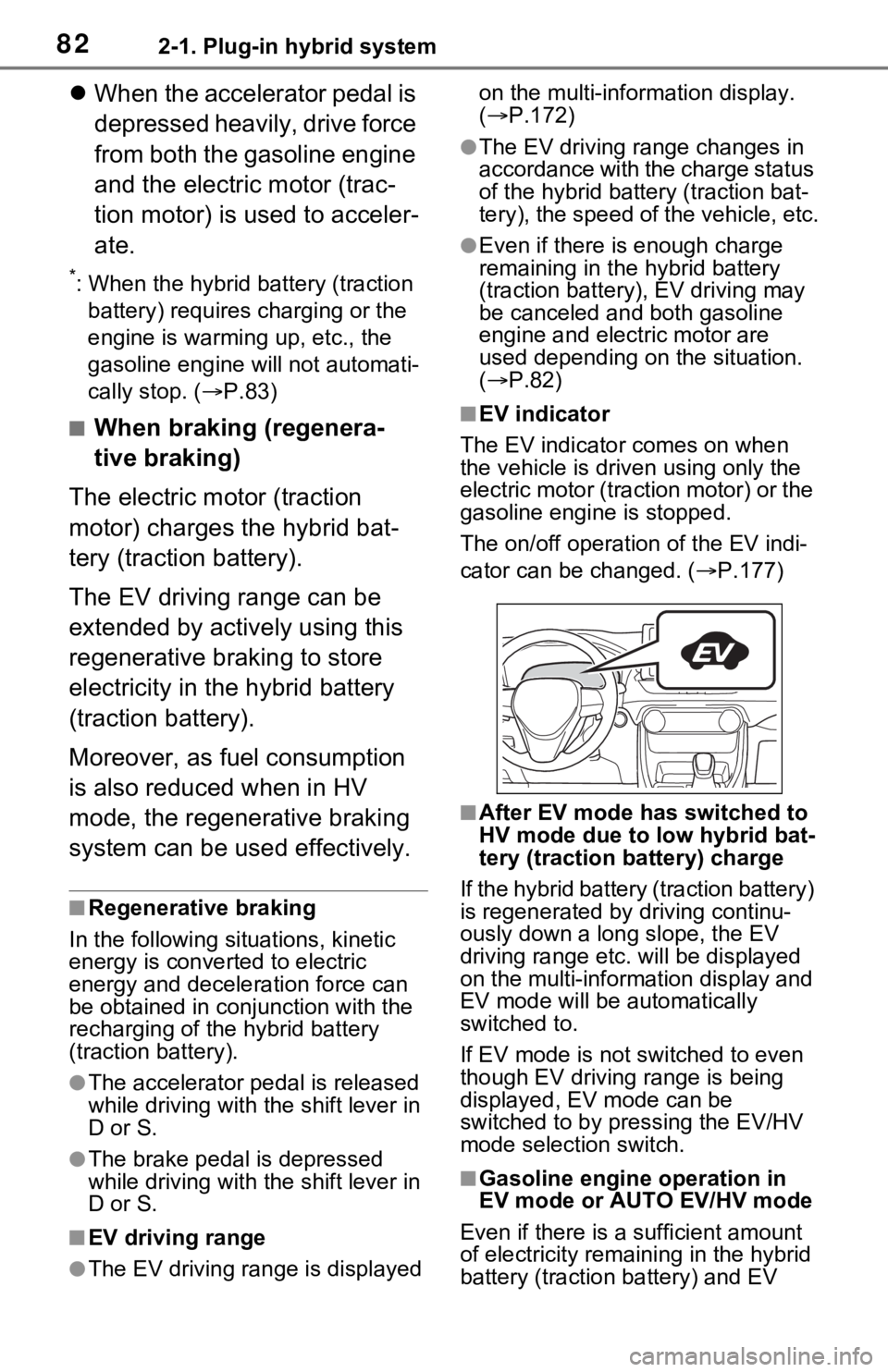
822-1. Plug-in hybrid system
When the accelerator pedal is
depressed heavily, drive force
from both the gasoline engine
and the electric motor (trac-
tion motor) is used to acceler-
ate.
*: When the hybrid battery (traction
battery) requires charging or the
engine is warming up, etc., the
gasoline engine will not automati-
cally stop. ( P.83)
■When braking (regenera-
tive braking)
The electric motor (traction
motor) charges the hybrid bat-
tery (traction battery).
The EV driving range can be
extended by actively using this
regenerative braking to store
electricity in the hybrid battery
(traction battery).
Moreover, as fuel consumption
is also reduced when in HV
mode, the regenerative braking
system can be used effectively.
■Regenerative braking
In the following si tuations, kinetic
energy is converted to electric
energy and deceleration force can
be obtained in conjunction with the
recharging of the hybrid battery
(traction battery).
●The accelerator pedal is released
while driving with the shift lever in
D or S.
●The brake pedal is depressed
while driving with the shift lever in
D or S.
■EV driving range
●The EV driving range is displayed on the multi-information display.
(
P.172)
●The EV driving range changes in
accordance with the charge status
of the hybrid battery (traction bat-
tery), the speed of the vehicle, etc.
●Even if there is enough charge
remaining in the hybrid battery
(traction battery), EV driving may
be canceled and both gasoline
engine and electric motor are
used depending on the situation.
( P.82)
■EV indicator
The EV indicator comes on when
the vehicle is driven using only the
electric motor (traction motor) or the
gasoline engine is stopped.
The on/off operation of the EV indi-
cator can be changed. ( P.177)
■After EV mode has switched to
HV mode due to low hybrid bat-
tery (traction battery) charge
I f t h e h y b r i d b a t t e r y (traction battery)
is regenerated by driving continu-
ously down a long slope, the EV
driving range etc. will be displayed
on the multi-information display and
EV mode will be a utomatically
switched to.
If EV mode is not switched to even
though EV driving range is being
displayed, EV mode can be
switched to by pressing the EV/HV
mode selection switch.
■Gasoline engine operation in
EV mode or AUTO EV/HV mode
Even if there is a sufficient amount
of electricity remaining in the hybrid
battery (traction battery) and EV
Page 83 of 616
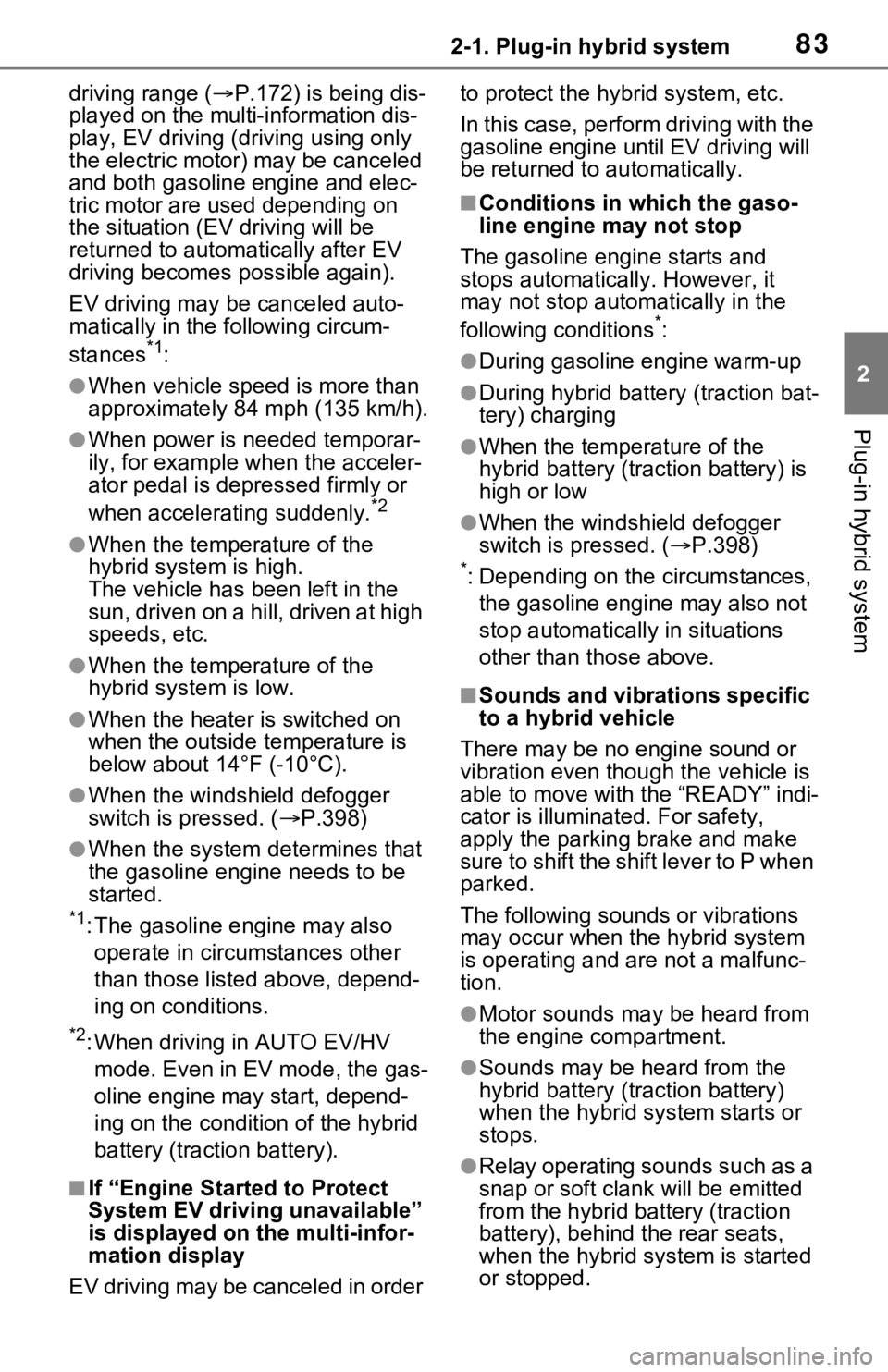
832-1. Plug-in hybrid system
2
Plug-in hybrid system
driving range (P.172) is being dis-
played on the multi-information dis-
play, EV driving (driving using only
the electric motor) may be canceled
and both gasoline engine and elec-
tric motor are used depending on
the situation (EV driving will be
returned to automatically after EV
driving becomes possible again).
EV driving may be canceled auto-
matically in the following circum-
stances
*1:
●When vehicle speed is more than
approximately 84 mph (135 km/h).
●When power is needed temporar-
ily, for example when the acceler-
ator pedal is depressed firmly or
when accelerating suddenly.
*2
●When the temperature of the
hybrid system is high.
The vehicle has been left in the
sun, driven on a hill, driven at high
speeds, etc.
●When the temperature of the
hybrid system is low.
●When the heater is switched on
when the outside temperature is
below about 14°F (-10°C).
●When the windshield defogger
switch is pressed. ( P.398)
●When the system determines that
the gasoline engine needs to be
started.
*1: The gasoline engine may also
operate in circumstances other
than those listed above, depend-
ing on conditions.
*2: When driving in AUTO EV/HV mode. Even in EV mode, the gas-
oline engine may start, depend-
ing on the condition of the hybrid
battery (traction battery).
■If “Engine Started to Protect
System EV driving unavailable”
is displayed on the multi-infor-
mation display
EV driving may be canceled in order to protect the hybrid system, etc.
In this case, perform driving with the
gasoline engine until EV driving will
be returned to automatically.
■Conditions in which the gaso-
line engine may not stop
The gasoline engine starts and
stops automatically. However, it
may not stop automatically in the
following conditions
*:
●During gasoline engine warm-up
●During hybrid battery (traction bat-
tery) charging
●When the temperature of the
hybrid battery (traction battery) is
high or low
●When the windshield defogger
switch is pressed. ( P.398)
*: Depending on the circumstances,
the gasoline engine may also not
stop automatically in situations
other than those above.
■Sounds and vibrations specific
to a hybrid vehicle
There may be no e ngine sound or
vibration even thoug h the vehicle is
able to move with the “READY” indi-
cator is illuminated. For safety,
apply the parking brake and make
sure to shift the shift lever to P when
parked.
The following sounds or vibrations
may occur when the hybrid system
is operating and are not a malfunc-
tion.
●Motor sounds may be heard from
the engine compartment.
●Sounds may be heard from the
hybrid battery (traction battery)
when the hybrid sy stem starts or
stops.
●Relay operating sounds such as a
snap or soft clank will be emitted
from the hybrid ba ttery (traction
battery), behind the rear seats,
when the hybrid system is started
or stopped.
Page 84 of 616
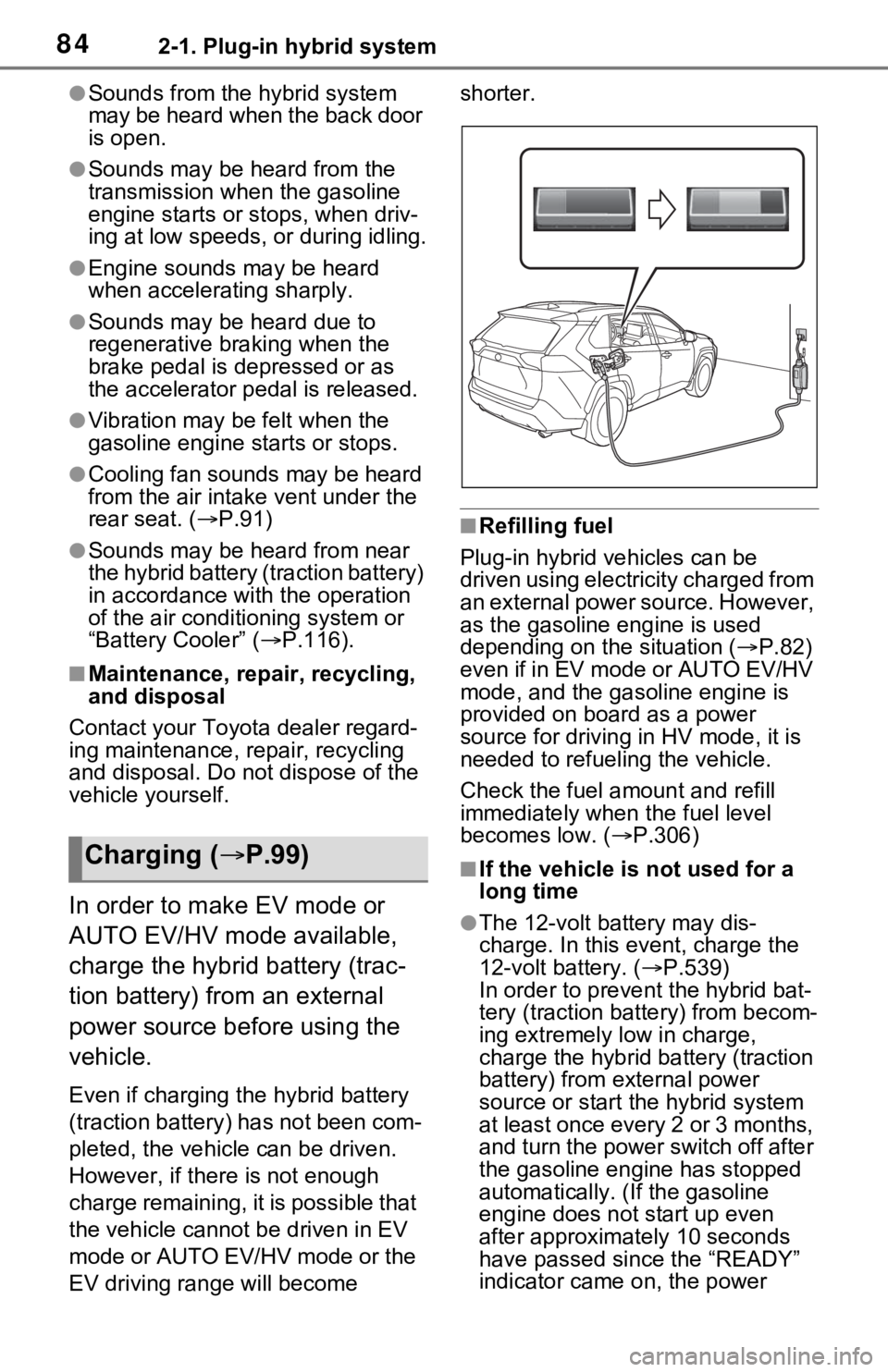
842-1. Plug-in hybrid system
●Sounds from the hybrid system
may be heard when the back door
is open.
●Sounds may be heard from the
transmission when the gasoline
engine starts or stops, when driv-
ing at low speeds, or during idling.
●Engine sounds may be heard
when accelerating sharply.
●Sounds may be heard due to
regenerative braking when the
brake pedal is dep ressed or as
the accelerator pedal is released.
●Vibration may be felt when the
gasoline engine starts or stops.
●Cooling fan sounds may be heard
from the air intake vent under the
rear seat. ( P.91)
●Sounds may be heard from near
the hybrid battery (traction battery)
in accordance with the operation
of the air conditioning system or
“Battery Cooler” ( P.116).
■Maintenance, repair, recycling,
and disposal
Contact your Toyota dealer regard-
ing maintenance, repair, recycling
and disposal. Do not dispose of the
vehicle yourself.
In order to make EV mode or
AUTO EV/HV mode available,
charge the hybrid battery (trac-
tion battery) from an external
power source before using the
vehicle.
Even if charging t he hybrid battery
(traction battery) has not been com-
pleted, the vehicle can be driven.
However, if there is not enough
charge remaining, it is possible that
the vehicle canno t be driven in EV
mode or AUTO EV/HV mode or the
EV driving range will become shorter.
■Refilling fuel
Plug-in hybrid vehicles can be
driven using electricity charged from
an external power source. However,
as the gasoline engine is used
depending on the situation ( P.82)
even if in EV mode or AUTO EV/HV
mode, and the gasoline engine is
provided on board as a power
source for driving in HV mode, it is
needed to refueling the vehicle.
Check the fuel a mount and refill
immediately when the fuel level
becomes low. ( P.306)
■If the vehicle is not used for a
long time
●The 12-volt battery may dis-
charge. In this e vent, charge the
12-volt battery. ( P.539)
In order to prevent the hybrid bat-
tery (traction batt ery) from becom-
ing extremely low in charge,
charge the hybrid battery (traction
battery) from external power
source or start th e hybrid system
at least once every 2 or 3 months,
and turn the power switch off after
the gasoline engine has stopped
automatically. ( If the gasoline
engine does not start up even
after approximately 10 seconds
have passed since the “READY”
indicator came on, the power
Charging ( P.99)
Page 85 of 616
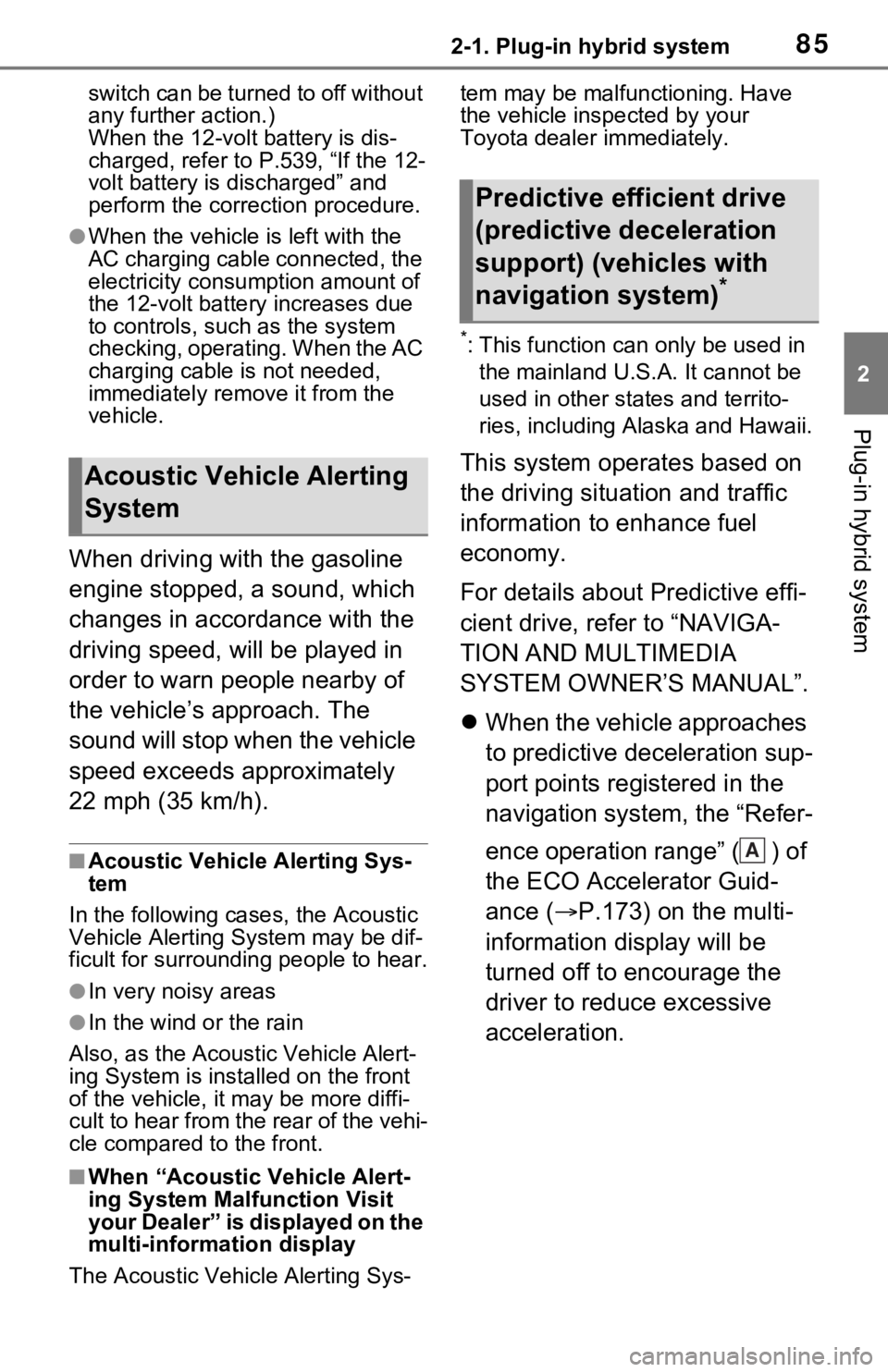
852-1. Plug-in hybrid system
2
Plug-in hybrid system
switch can be turned to off without
any further action.)
When the 12-volt battery is dis-
charged, refer to P.539, “If the 12-
volt battery is discharged” and
perform the corr ection procedure.
●When the vehicle is left with the
AC charging cable connected, the
electricity consumption amount of
the 12-volt battery increases due
to controls, such as the system
checking, operating. When the AC
charging cable is not needed,
immediately remove it from the
vehicle.
When driving with the gasoline
engine stopped, a sound, which
changes in accordance with the
driving speed, will be played in
order to warn people nearby of
the vehicle’s approach. The
sound will stop when the vehicle
speed exceeds approximately
22 mph (35 km/h).
■Acoustic Vehicle Alerting Sys-
tem
In the following cases, the Acoustic
Vehicle Alerting Sy stem may be dif-
ficult for surrounding people to hear.
●In very noisy areas
●In the wind or the rain
Also, as the Acoustic Vehicle Alert-
ing System is installed on the front
of the vehicle, it may be more diffi-
cult to hear from the rear of the vehi-
cle compared to the front.
■When “Acoustic Vehicle Alert-
ing System Malfunction Visit
your Dealer” is displayed on the
multi-information display
The Acoustic Vehicle Alerting Sys- tem may be malf
unctioning. Have
the vehicle inspected by your
Toyota dealer immediately.
*: This function can only be used in
the mainland U.S.A. It cannot be
used in other states and territo-
ries, including Alaska and Hawaii.
This system operates based on
the driving situation and traffic
information to enhance fuel
economy.
For details about Predictive effi-
cient drive, refer to “NAVIGA-
TION AND MULTIMEDIA
SYSTEM OWNER’S MANUAL”.
When the vehicle approaches
to predictive deceleration sup-
port points registered in the
navigation system, the “Refer-
ence operation range” ( ) of
the ECO Accelerator Guid-
ance ( P.173) on the multi-
information display will be
turned off to encourage the
driver to reduce excessive
acceleration.Acoustic Vehicle Alerting
System
Predictive efficient drive
(predictive deceleration
support) (vehicles with
navigation system)
*
A
Page 86 of 616
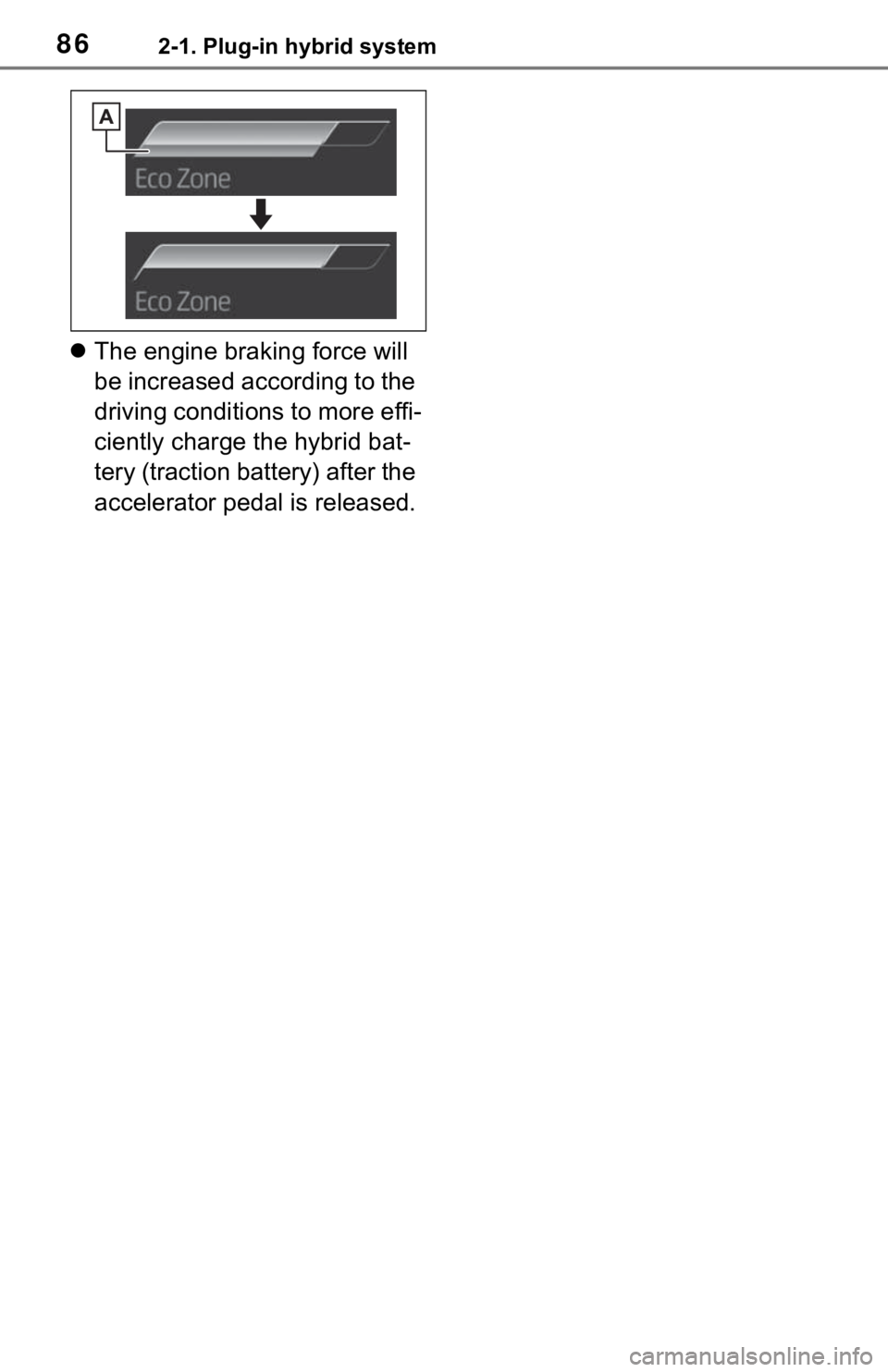
862-1. Plug-in hybrid system
The engine braking force will
be increased according to the
driving conditions to more effi-
ciently charge the hybrid bat-
tery (traction battery) after the
accelerator pedal is released.
Page 91 of 616
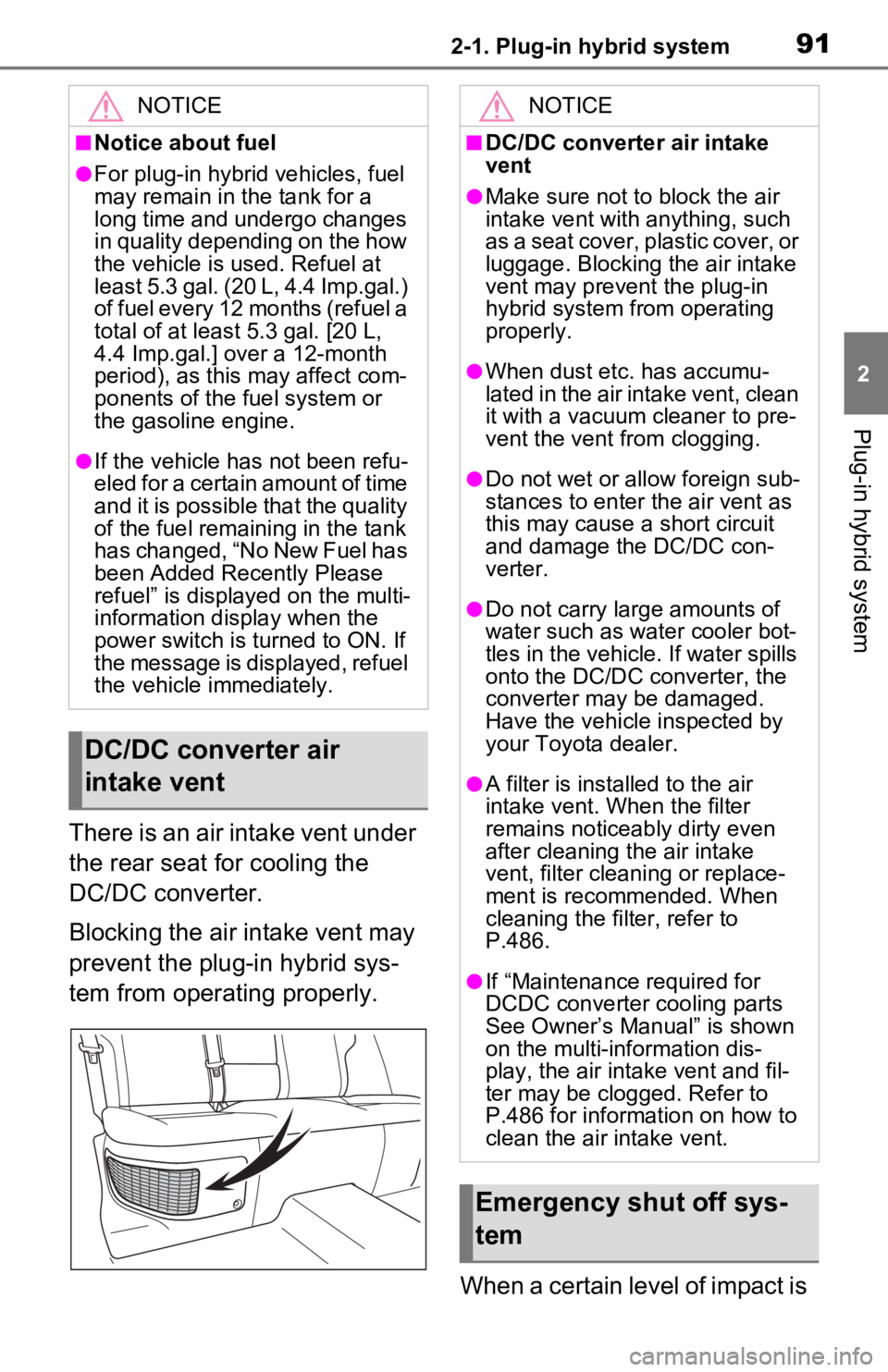
912-1. Plug-in hybrid system
2
Plug-in hybrid system
There is an air intake vent under
the rear seat for cooling the
DC/DC converter.
Blocking the air intake vent may
prevent the plug-in hybrid sys-
tem from operating properly.When a certain level of impact is
NOTICE
■Notice about fuel
●For plug-in hybrid vehicles, fuel
may remain in the tank for a
long time and undergo changes
in quality depending on the how
the vehicle is used. Refuel at
least 5.3 gal. (20 L, 4.4 Imp.gal.)
of fuel every 12 months (refuel a
total of at least 5 .3 gal. [20 L,
4.4 Imp.gal.] over a 12-month
period), as this may affect com-
ponents of the fuel system or
the gasoline engine.
●If the vehicle has not been refu-
eled for a certain amount of time
and it is possible that the quality
of the fuel remaining in the tank
has changed, “No New Fuel has
been Added Recently Please
refuel” is displayed on the multi-
information display when the
power switch is turned to ON. If
the message is displayed, refuel
the vehicle immediately.
DC/DC converter air
intake vent
NOTICE
■DC/DC converte r air intake
vent
●Make sure not to block the air
intake vent with anything, such
as a seat cover, plastic cover, or
luggage. Blocking the air intake
vent may prevent the plug-in
hybrid system from operating
properly.
●When dust etc. has accumu-
lated in the air intake vent, clean
it with a vacuum cleaner to pre-
vent the vent from clogging.
●Do not wet or allow foreign sub-
stances to enter the air vent as
this may cause a short circuit
and damage the DC/DC con-
verter.
●Do not carry large amounts of
water such as water cooler bot-
tles in the vehicle. If water spills
onto the DC/DC converter, the
converter may be damaged.
Have the vehicle inspected by
your Toyota dealer.
●A filter is installed to the air
intake vent. When the filter
remains noticeably dirty even
after cleaning the air intake
vent, filter cleaning or replace-
ment is recommended. When
cleaning the filter, refer to
P.486.
●If “Maintenance required for
DCDC converter cooling parts
See Owner’s Manual” is shown
on the multi-information dis-
play, the air intake vent and fil-
ter may be clogged. Refer to
P.486 for information on how to
clean the air intake vent.
Emergency shut off sys-
tem
Page 93 of 616
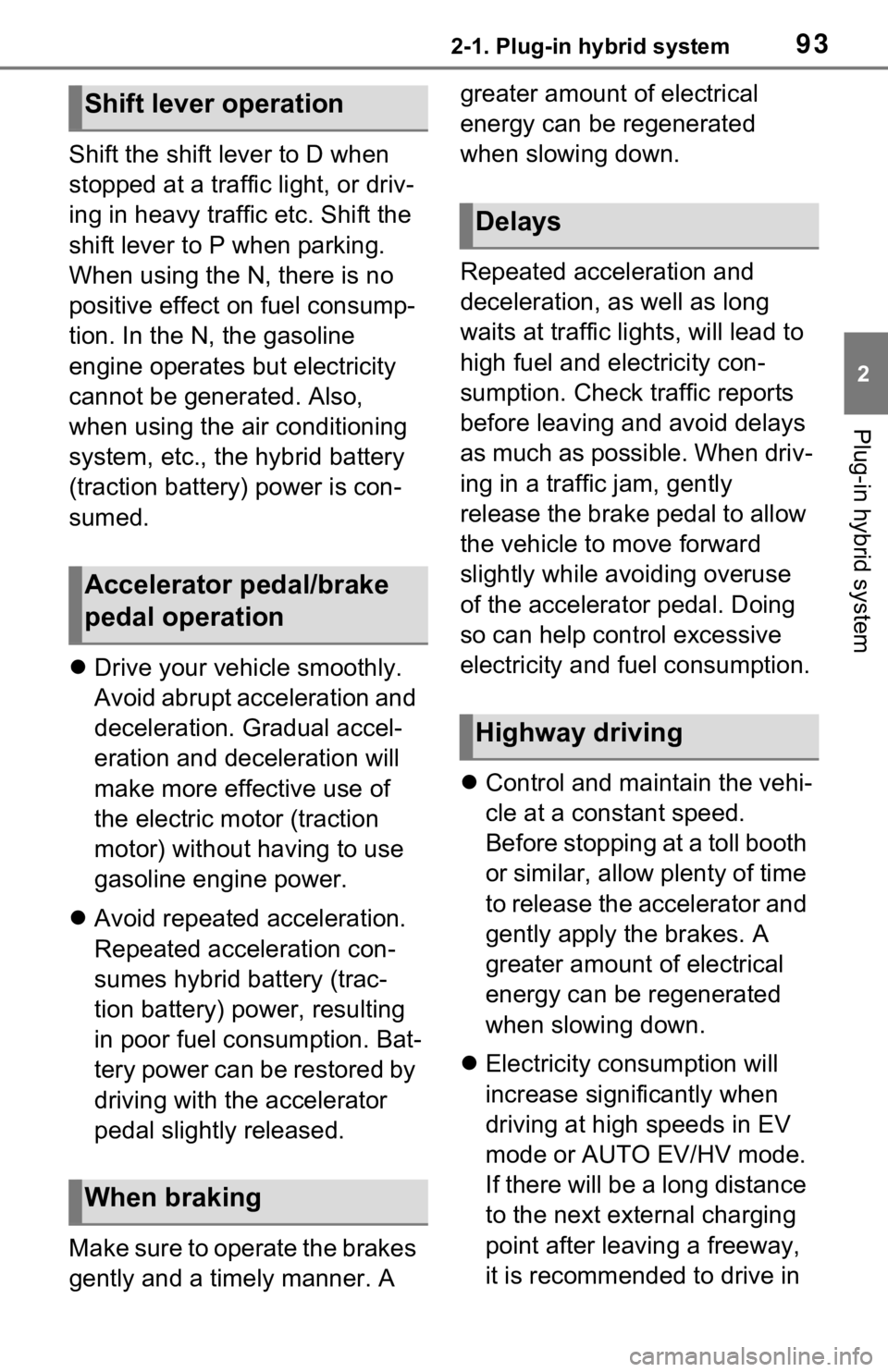
932-1. Plug-in hybrid system
2
Plug-in hybrid system
Shift the shift lever to D when
stopped at a traffic light, or driv-
ing in heavy traffic etc. Shift the
shift lever to P when parking.
When using the N, there is no
positive effect on fuel consump-
tion. In the N, the gasoline
engine operates but electricity
cannot be generated. Also,
when using the air conditioning
system, etc., the hybrid battery
(traction battery) power is con-
sumed.
Drive your vehicle smoothly.
Avoid abrupt acceleration and
deceleration. Gradual accel-
eration and deceleration will
make more effective use of
the electric motor (traction
motor) without having to use
gasoline engine power.
Avoid repeated acceleration.
Repeated acceleration con-
sumes hybrid battery (trac-
tion battery) power, resulting
in poor fuel consumption. Bat-
tery power can be restored by
driving with the accelerator
pedal slightly released.
Make sure to operate the brakes
gently and a timely manner. A greater amount of electrical
energy can be regenerated
when slowing down.
Repeated acceleration and
deceleration, as well as long
waits at traffic lights, will lead to
high fuel and electricity con-
sumption. Check traffic reports
before leaving and avoid delays
as much as possible. When driv-
ing in a traffic jam, gently
release the brake pedal to allow
the vehicle to move forward
slightly while avoiding overuse
of the accelerator pedal. Doing
so can help control excessive
electricity and fuel consumption.
Control and maintain the vehi-
cle at a constant speed.
Before stopping at a toll booth
or similar, allow plenty of time
to release the accelerator and
gently apply the brakes. A
greater amount of electrical
energy can be regenerated
when slowing down.
Electricity consumption will
increase significantly when
driving at high speeds in EV
mode or AUTO EV/HV mode.
If there will be a long distance
to the next external charging
point after leaving a freeway,
it is recommended to drive in
Shift lever operation
Accelerator pedal/brake
pedal operation
When braking
Delays
Highway driving
Page 94 of 616
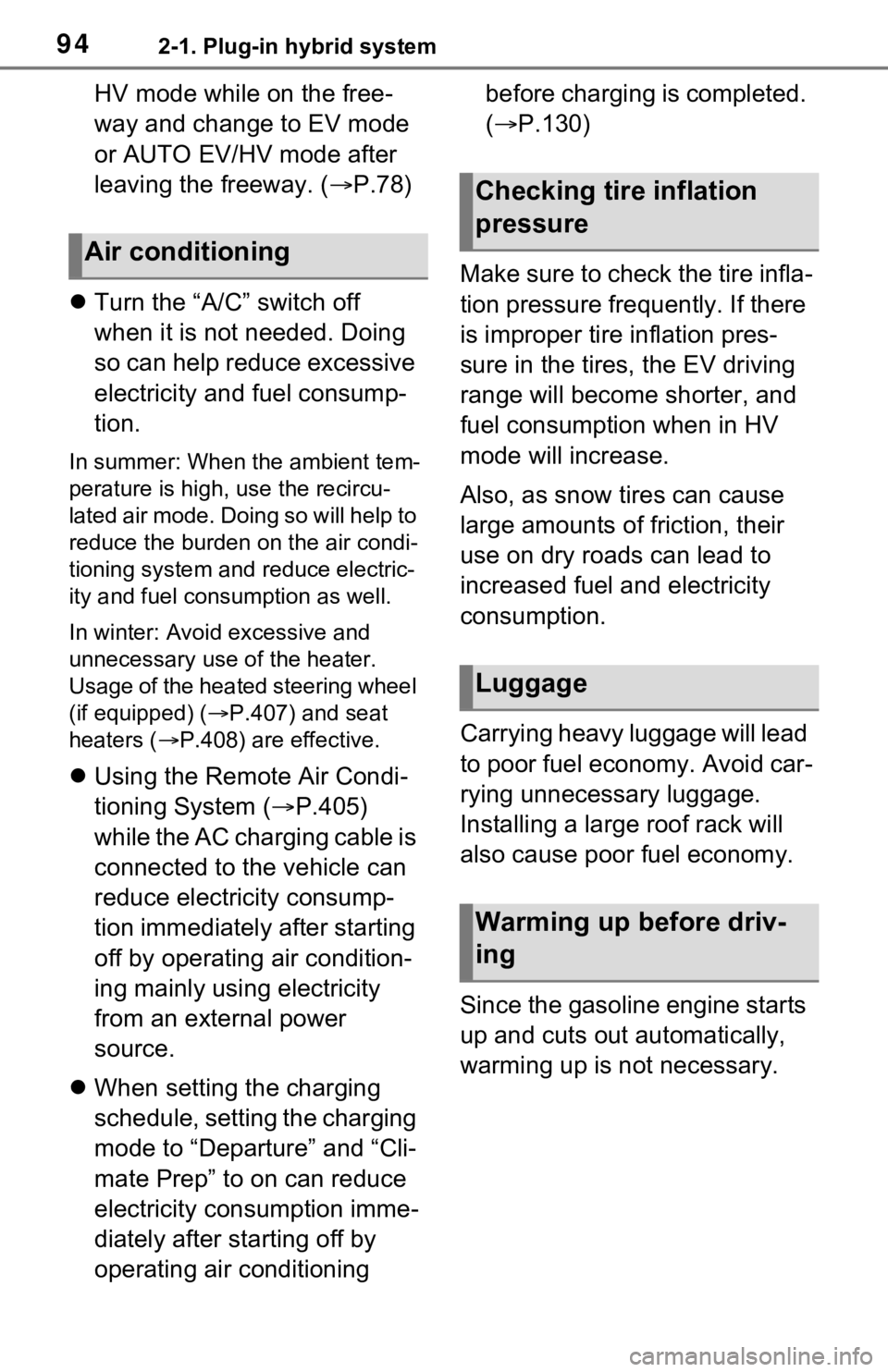
942-1. Plug-in hybrid system
HV mode while on the free-
way and change to EV mode
or AUTO EV/HV mode after
leaving the freeway. (P.78)
Turn the “A/C” switch off
when it is not needed. Doing
so can help reduce excessive
electricity and fuel consump-
tion.
In summer: When the ambient tem-
perature is high, use the recircu-
lated air mode. Doing so will help to
reduce the burden on the air condi-
tioning system and reduce electric-
ity and fuel consumption as well.
In winter: Avoid excessive and
unnecessary use o f the heater.
Usage of the heated steering wheel
(if equipped) ( P.407) and seat
heaters ( P.408) are effective.
Using the Remote Air Condi-
tioning System ( P.405)
while the AC charging cable is
connected to the vehicle can
reduce electricity consump-
tion immediately after starting
off by operating air condition-
ing mainly using electricity
from an external power
source.
When setting the charging
schedule, setting the charging
mode to “Departure” and “Cli-
mate Prep” to on can reduce
electricity consumption imme-
diately after starting off by
operating air conditioning before charging is completed.
(
P.130)
Make sure to check the tire infla-
tion pressure frequently. If there
is improper tire inflation pres-
sure in the tires, the EV driving
range will become shorter, and
fuel consumption when in HV
mode will increase.
Also, as snow tires can cause
large amounts of friction, their
use on dry roads can lead to
increased fuel and electricity
consumption.
Carrying heavy luggage will lead
to poor fuel economy. Avoid car-
rying unnecessary luggage.
Installing a large roof rack will
also cause poor fuel economy.
Since the gasoline engine starts
up and cuts out automatically,
warming up is not necessary.
Air conditioning
Checking tire inflation
pressure
Luggage
Warming up before driv-
ing
Page 95 of 616
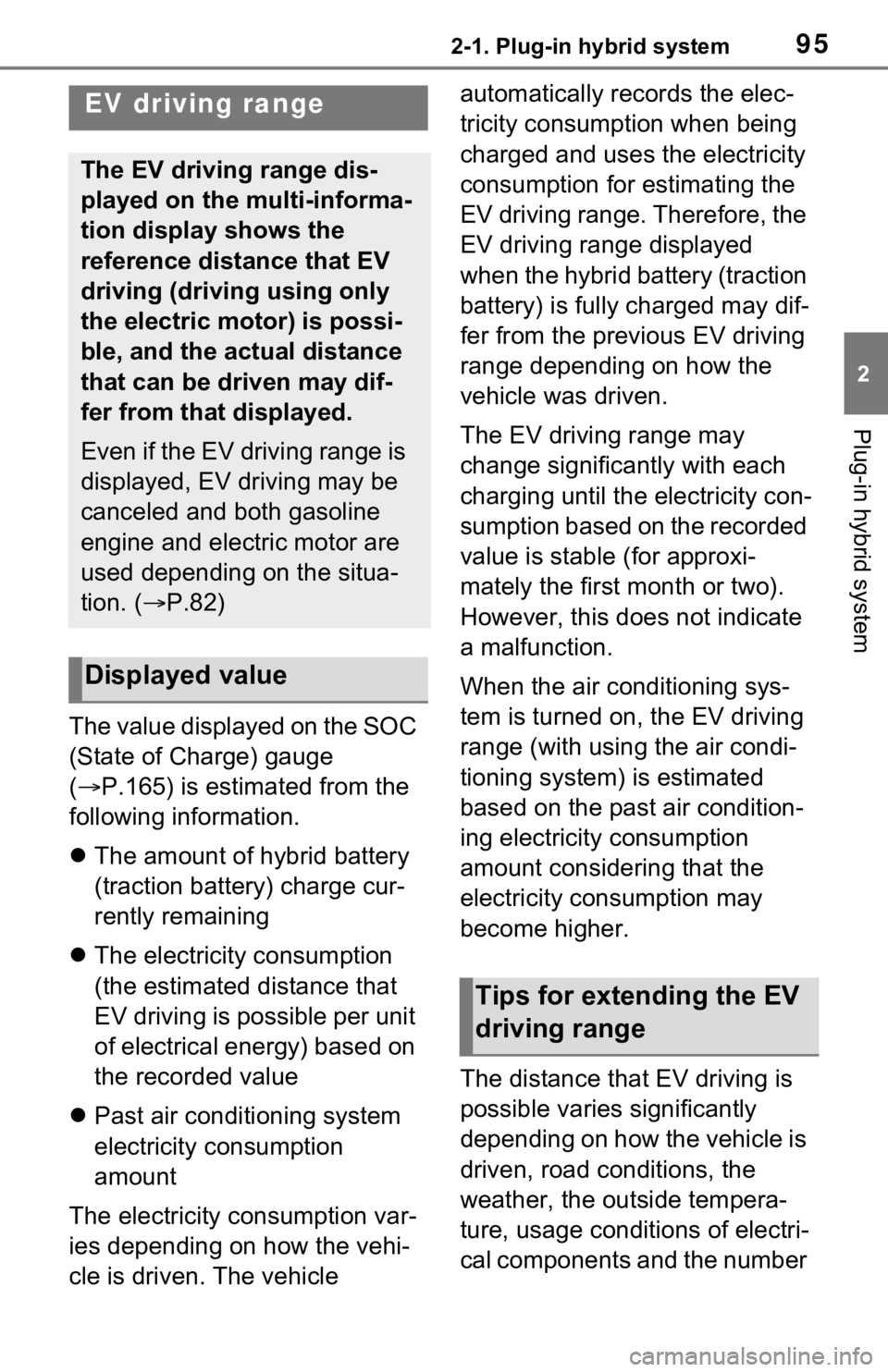
952-1. Plug-in hybrid system
2
Plug-in hybrid system
The value displayed on the SOC
(State of Charge) gauge
(P.165) is estimated from the
following information.
The amount of hybrid battery
(traction battery) charge cur-
rently remaining
The electricity consumption
(the estimated distance that
EV driving is possible per unit
of electrical energy) based on
the recorded value
Past air conditioning system
electricity consumption
amount
The electricity consumption var-
ies depending on how the vehi-
cle is driven. The vehicle automatically records the elec-
tricity consumption when being
charged and uses the electricity
consumption for estimating the
EV driving range. Therefore, the
EV driving range displayed
when the hybrid battery (traction
battery) is fully charged may dif-
fer from the previous EV driving
range depending on how the
vehicle was driven.
The EV driving range may
change significantly with each
charging until the electricity con-
sumption based on the recorded
value is stable (for approxi-
mately the first month or two).
However, this does not indicate
a malfunction.
When the air conditioning sys-
tem is turned on, the EV driving
range (with using the air condi-
tioning system) is estimated
based on the past air condition-
ing electricity consumption
amount considering that the
electricity consumption may
become higher.
The distance that EV driving is
possible varies significantly
depending on how the vehicle is
driven, road conditions, the
weather, the outside tempera-
ture, usage conditions of electri-
cal components and the number
EV driving range
The EV driving range dis-
played on the multi-informa-
tion display shows the
reference distance that EV
driving (driving using only
the electric motor) is possi-
ble, and the actual distance
that can be driven may dif-
fer from that displayed.
Even if the EV driving range is
displayed, EV driving may be
canceled and both gasoline
engine and electric motor are
used depending on the situa-
tion. (
P.82)
Displayed value
Tips for extending the EV
driving range
Page 114 of 616
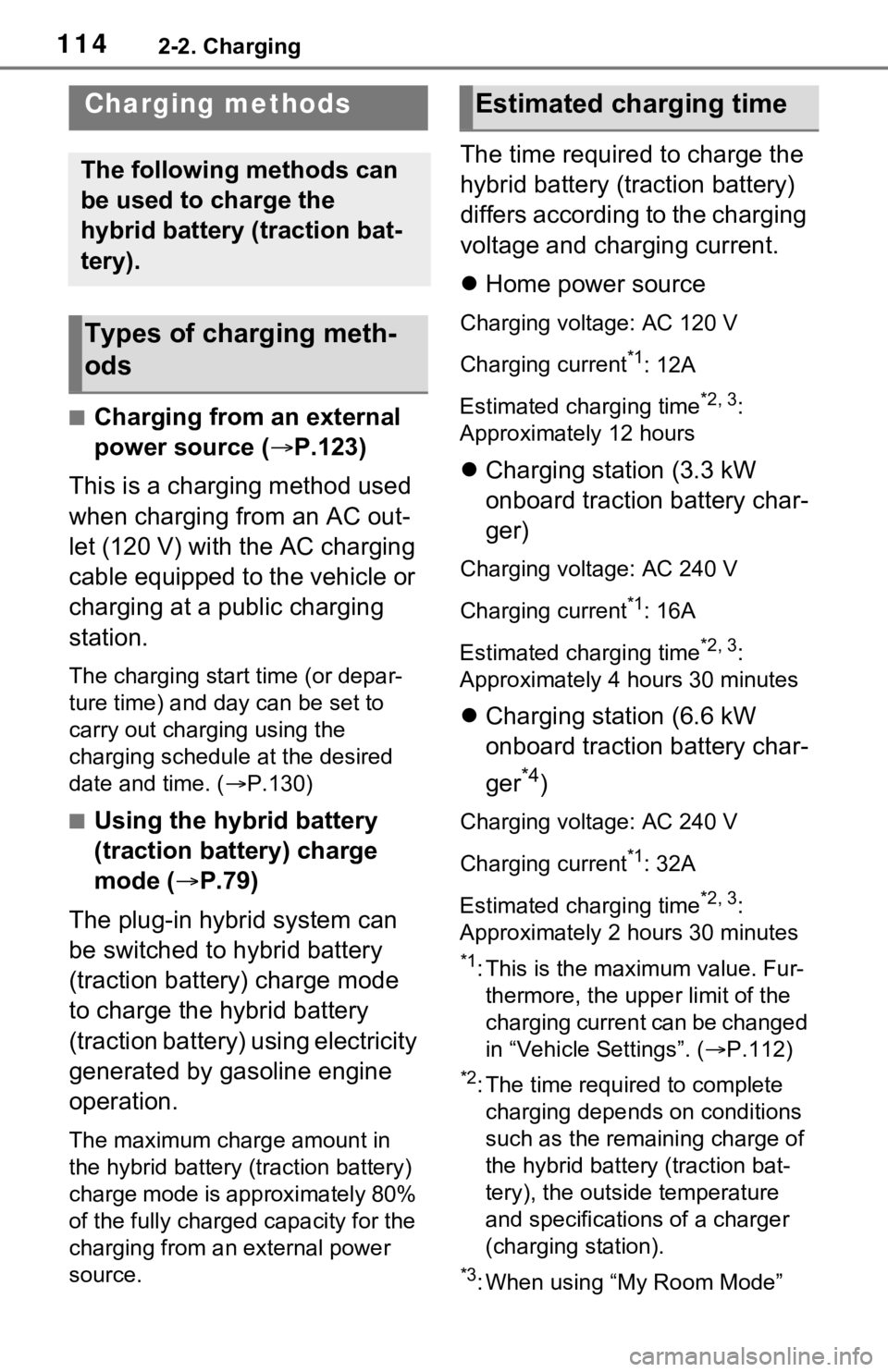
1142-2. Charging
■Charging from an external
power source (P.123)
This is a charging method used
when charging from an AC out-
let (120 V) with the AC charging
cable equipped to the vehicle or
charging at a public charging
station.
The charging start time (or depar-
ture time) and day can be set to
carry out charging using the
charging schedule at the desired
date and time. ( P.130)
■Using the hybrid battery
(traction battery) charge
mode ( P.79)
The plug-in hybrid system can
be switched to hybrid battery
(traction battery) charge mode
to charge the hybrid battery
(traction battery) using electricity
generated by gasoline engine
operation.
The maximum charge amount in
the hybrid battery (traction battery)
charge mode is approximately 80%
of the fully charged capacity for the
charging from an external power
source.
The time required to charge the
hybrid battery (traction battery)
differs according to the charging
voltage and charging current.
Home power source
Charging voltage: AC 120 V
Charging current
*1: 12A
Estimated charging time
*2, 3:
Approximately 12 hours
Charging station (3.3 kW
onboard traction battery char-
ger)
Charging voltage: AC 240 V
Charging current
*1: 16A
Estimated charging time
*2, 3:
Approximately 4 hours 30 minutes
Charging station (6.6 kW
onboard traction battery char-
ger
*4)
Charging voltage: AC 240 V
Charging current
*1: 32A
Estimated charging time
*2, 3:
Approximately 2 hours 30 minutes
*1: This is the maximum value. Fur- thermore, the upper limit of the
charging current can be changed
in “Vehicle Settings”. ( P.112)
*2: The time required to complete
charging depends on conditions
such as the remaining charge of
the hybrid battery (traction bat-
tery), the outside temperature
and specifications of a charger
(charging station).
*3: When using “My Room Mode”
Charging methods
The following methods can
be used to charge the
hybrid battery (traction bat-
tery).
Types of charging meth-
ods
Estimated charging time